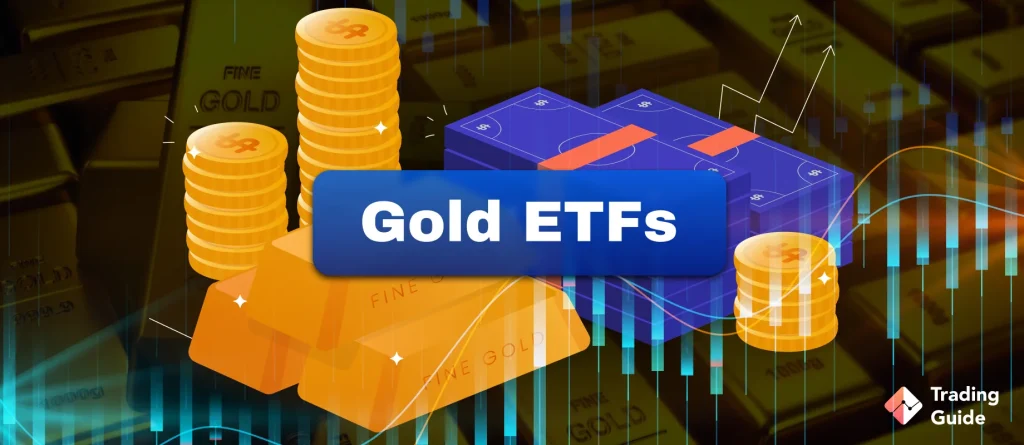Buying physical gold has long been favoured by investors. However, the challenges of storage and liquidity can be daunting, leaving many looking for the best way to trade gold. Fortunately, trading on gold ETFs saves the day by offering higher liquidity, transparent transactions, no storage headaches, and other benefits.
If you want to learn more about how to purchase gold ETF, join us as we explore this gold trading method. Not only will you be familiar with the features and advantages of investing in gold ETFs, but we will also list for you our top gold ETFs you should consider this year. The main goal is to ensure you are fully prepared to dive into the world of gold ETF without any hurdles.
What is an ETF?

An ETF (Exchange-Traded Fund) is a popular investment vehicle that combines the features of both stocks and mutual funds. It is designed to track the performance of a specific index, such as a stock index or a commodity index, like gold.
Like a mutual fund, an ETF pools money from multiple investors and uses it to invest in a diversified portfolio of assets. However, what sets ETFs apart is that they are traded via brokers with access to stock exchanges, just like regular stocks/shares. This means, investors can buy or sell ETF shares throughout the day at market prices, providing them with flexibility and liquidity.
ETFs offer a wide range of investment opportunities, allowing investors to gain exposure to various asset classes, sectors, or regions. Simply put, ETFs are cost-effective and provide a convenient way to diversify a portfolio, as they typically have lower expense ratios compared to traditional mutual funds. However, investors interested in brokerage mutual funds should explore these options for specific investment strategies or managed portfolios.
What is a Gold ETF?
Trading commodities carries risks such as market volatility, leveraged positions, and the potential for substantial losses. To manage these risks, diversify your investments, use stop-loss and take-profit orders, and trade with funds you can afford to lose. Additionally, stay informed about market factors, adhere to a well-defined trading plan, and guard against emotional decision-making.
It is also crucial to comply with market regulations and be cautious of counterparty risk. Regularly reassessing your risk tolerance and trading strategies will help you trade responsibly and maximise profitability.
A gold ETF is a type of commodity ETF that allows traders to gain exposure to gold price movements without owning the physical asset. Gold ETF is designed to track the performance of gold bullion or gold-related indices.
Regarding digital gold vs gold ETF, gold ETF offers a convenient and cost-effective alternative. When you trade a Gold ETF, you are buying shares that represent a proportional interest in the underlying gold assets held by the fund. This means that as gold’s value fluctuates, the price of your gold ETF shares will correspondingly rise or fall.
Similar to other ETFs, Gold ETFs are traded on stock exchanges, allowing investors to buy or sell shares at market prices throughout the trading day. This liquidity makes it easier for you to efficiently open and close positions.
How a Gold ETF Work
Gold ETFs work by holding physical gold or gold derivatives in their portfolios. The ETF issuer acquires and stores gold bullion or enters into derivative contracts that are backed by physical gold. The value of the gold ETF is directly linked to the price movements of gold.
When an investor buys shares of a Gold ETF, they are effectively buying a portion of the underlying gold assets held by the fund. The shares you own must correspond to your proportional ownership of the gold holdings.
Note that the value of a gold ETF share is influenced by the price of gold in the market. As the price of gold increases, the value of the gold ETF share rises, and vice versa. Investors can monitor the performance of their gold ETF investment by tracking the fund’s net asset value, which reflects the current value of the underlying gold assets.
Different Types of Gold ETFs

Gold ETFs offer investors a variety of options to gain exposure to the precious metal. Below are the different types of Gold ETFs available in the market.
- Physical Gold ETFs: These are the most common types of Gold ETFs. They hold physical gold bullion as their underlying asset. Each share of the ETF represents a specific amount of gold, typically measured in ounces. Physical Gold ETFs aim to closely track the price of gold by holding and storing the physical metal.
- Gold Miner ETFs: These ETFs invest in companies involved in gold mining and exploration. Instead of holding physical gold, these ETFs own shares of gold mining companies. The performance of Gold Miner ETFs is influenced by various factors, including the price of gold, production costs, and the overall profitability of the mining companies.
- Futures-Based Gold ETFs: These ETFs invest in gold futures contracts rather than physical gold. They aim to track the performance of gold prices through derivative instruments. Futures-based Gold ETFs can offer exposure to gold without the need for physical storage. Still, they are subject to additional risks associated with futures contracts, such as roll costs and potential market volatility.
- Inverse Gold ETFs: Inverse Gold ETFs are designed to provide returns that are inversely correlated to the price of gold. These ETFs use various strategies, such as derivatives or short selling, to achieve negative returns when the price of gold declines. Inverse Gold ETFs are typically used by investors as a hedging or speculative tool to profit from falling gold prices.
- Leveraged Gold ETFs: Leveraged Gold ETFs aim to provide amplified returns relative to the performance of gold prices. They use financial derivatives and borrowing to magnify the investment results. These ETFs can provide increased exposure to gold price movements but also carry higher risks due to leverage, including potential losses that exceed the initial investment.
How to Invest in Gold ETF?

As mentioned earlier, you need the best ETF broker to effectively trade gold ETF. However, do you know the procedures involved in investing in the asset? Here are the simple procedures on how to invest in gold ETF.
- Research and Select a Gold ETF – Begin by researching different Gold ETF options available in the market. Consider factors such as the ETF’s objective, expense ratio, tracking error, liquidity, and assets under management. Select an ETF that aligns with your investment goals and preferences.
- Open a Brokerage Account – To invest in Gold ETFs, you’ll need to open an ETF trading account with a reputable and reliable ETF broker. Compare brokerage options based on fees, available investment products, trading platform features, and customer support.
- Fund Your Account – Once your trading account is set up, fund it with the desired amount of capital you intend to invest in Gold ETFs. Ensure your account has sufficient capital to cover the investment and associated trading costs.
- Place Your Trade – Using your broker’s trading platform, search for the specific Gold ETF you wish to invest in. You can use the Gold ETF ticker symbol for a quick search and indicate the number of shares or the amount you want to invest. Review the trade details and submit the order.
- Monitor and Manage Your Investment – After investing in a Gold ETF, it’s essential to monitor its performance regularly. Stay informed about any news or developments related to the gold market and the specific ETF you have invested in. Consider setting up price alerts or notifications to stay updated on significant price movements.
Remember, investing in Gold ETFs carries market risks, including the potential for loss of money. As a trader, it is crucial to conduct thorough research, understand various gold price tips, and only invest amounts you are willing to risk. Consulting with a financial advisor can also provide personalised guidance tailored to your specific financial situation and investment objectives.
Pros and Cons to Invest in Gold ETF
ETFs can be like a basket of opportunities, but remember, they’re not immune to market shifts. Just as the seasons change, so can the value of your ETF investments. Before diving in, take time to explore what’s inside the basket – understand the assets, their track record, and potential pitfalls. Think of ETFs like a treasure map; you want to ensure you’re not led astray. Watch out for hidden costs and tracking errors, as these can be the dragons on your path to returns. A careful approach to ETF investing is your compass through the market’s wilderness, helping you navigate potential risks while optimising your investment journey.
Investing in Gold ETFs offers a range of advantages and considerations that investors should carefully evaluate. These include:
Pros
- Convenience and Accessibility: Gold ETFs allow you to easily explore gold’s price movements without needing physical gold. You can buy and sell them via ETF brokers with access to stock exchanges like individual stocks, offering ease of trading and liquidity.
- Diversification: Gold ETFs allow investors to diversify their portfolios by adding exposure to the gold market. Gold has historically demonstrated a low correlation to other asset classes, which can help mitigate overall portfolio risk.
- Lower Costs: Gold ETFs typically have lower costs compared to owning physical bullion that comes with storage expenses. These lower costs can contribute to improved long-term investment returns, making Gold ETFs an attractive option for cost-conscious investors.
- Transparency: Gold ETFs provide transparency regarding their holdings and pricing. Investors can easily access information about the ETF’s net asset value, underlying gold holdings, and historical performance, enabling informed investment decisions.
- Flexibility: Gold ETFs offer the flexibility to invest in gold without the challenges of storing and securing physical gold. Investors can gain exposure to the ETF throughout the trading day, allowing for quick entry or exit from positions.
- Liquidity: Investing in gold ETFs requires a small capital compared to mutual funds. This allows traders to explore the ETF throughout the day and capitalise on price changes.
Cons
- Market Volatility: Gold prices can be subject to significant volatility, influenced by factors such as economic conditions, geopolitical events, and investor sentiment. The value of Gold ETFs can fluctuate accordingly, potentially leading to capital losses.
- No Ownership of Physical Gold: While Gold ETFs track the price of gold, investors do not own physical gold directly. Some investors prefer the tangibility and security of owning physical gold, which Gold ETFs do not provide.
- Counterparty Risk: Gold ETFs are subject to counterparty risk, as investors rely on the financial stability and performance of the ETF issuer. In the event of the issuer’s insolvency or failure, there could be potential risks to the investment.
- Dividend Income and Tax Considerations: Gold ETFs generally do not provide regular dividend income like stocks or interest income like bonds. Investors should understand the tax implications associated with any dividends or capital gains generated by Gold ETF investments.
Read more about what is a Dividend ETF at our trading blog.
List of the Top Gold ETFs
When considering investing in Gold ETFs, one must be aware of some of the top-performing and widely recognised options in the market. So, what is the best gold ETF? Let’s explore below a list of some of the leading Gold ETFs.
- SPDR Gold Shares (GLD): The SPDR Gold Shares is a popular Gold ETF that aims to track the price performance of gold bullion. GLD offers investors a cost-effective way to gain exposure to the price of gold.
- iShares Gold Trust (IAU): The iShares Gold Trust is another prominent Gold ETF designed to track the performance of the price of gold. It provides investors with access to physical gold through a secure and transparent structure. IAU is known for its relatively low expense ratio and high trading volume.
- Aberdeen Standard Physical Gold Shares ETF (SGOL): SGOL seeks to track the price of gold by holding allocated physical gold bullion. It offers investors a way to explore gold with the added benefit of the physical metal being held in a secure vault in Switzerland.
- GraniteShares Gold Trust (BAR): The GraniteShares Gold Trust aims to track the performance of the price of gold by holding physical gold bars. BAR offers a low expense ratio and is structured to provide transparency and simplicity for investors seeking exposure to gold.
- VanEck Vectors Gold Miners ETF (GDX): While not a direct gold ETF, the VanEck Vectors Gold Miners ETF provides exposure to gold through investing in companies engaged in gold mining. GDX offers investors the opportunity to gain exposure to the performance of gold mining companies.
- Invesco DB Gold Fund (DGL): The Invesco DB Gold Fund provides exposure to gold futures contracts rather than physical gold. DGL aims to track the performance of the DBIQ Optimum Yield Gold Index Excess Return. It offers investors an alternative way to invest in gold without the need for physical storage.
FAQs
Yes. Gold ETFs are generally considered to be a relatively safe investment option. They provide investors with exposure to the price movements of gold without the need to own physical gold. However, gold ETF carries risks, and it is crucial to conduct thorough market analysis and be strategic for increased profitability.
Absolutely. The suitability of Gold ETFs as an investment depends on individual circumstances and investment goals. Gold ETFs can be a good investment for diversification purposes, as it has historically shown a low correlation to other asset classes. It also offers convenience, liquidity, and lower costs compared to owning physical gold.
The choice between physical gold and gold ETFs depends on various factors, including personal preferences, investment goals, and practical considerations. Physical gold provides tangible ownership and can be seen as a long-term store of value. Gold ETFs offer the convenience of buying and selling shares on stock exchanges, providing exposure to gold price movements without the need for physical storage.
To buy HDFC gold ETF or any specific Gold ETF, you must first identify a credible and reliable broker featuring the HDFC gold ETF. Then, sign up for a trading account with the broker and deposit funds before placing your trade. Remember, constantly track your activities so you never miss out on arising opportunities that could be beneficial.
Conclusion
Gold ETFs offer a hassle-free and cost-effective way for investors to participate in the gold market and diversify their portfolios. With the potential to provide stability and act as a hedge against market volatility, Gold ETFs have become a preferred choice for many. Their ease of transaction, liquidity, and accessibility make them an attractive investment instrument.
To trade safely, always conduct thorough research and choose a reputable Gold broker ETF with features suitable for your needs. Plus, understand the basics and benefits of trading with gold ETFs to navigate the market with confidence and potentially capitalise on the performance of gold.



